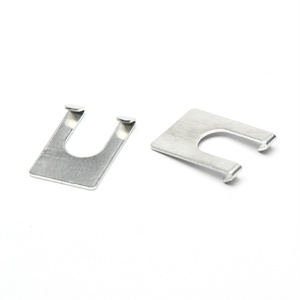Aluminum Stamping Parts Battery Contacts offer the following features and advantages:
Lightweight: The density of aluminum is relatively low, and the use of aluminum stamped battery contacts helps reduce the weight of the entire cell module, which is important in weight sensitive applications such as portable electronics and electric vehicles.
Good conductivity: Although the conductivity of aluminum is not as good as that of copper, the aluminum stamped parts after proper treatment can still meet the conductivity requirements of battery contacts in some occasions where the conductivity requirements are not very high.
Cost effectiveness: Aluminium is typically more economical than other commonly used conductive materials such as copper and can reduce the cost of producing battery contacts.
Machinability: Aluminum has good punching performance and can produce a variety of complex shapes and precise dimensions of battery contacts.
However, there are some challenges with aluminum stamped battery contacts:
Surface oxidation: Aluminum tends to form an oxide layer on the surface, which may increase the contact resistance and affect the conductivity. Special surface treatments are required to solve this problem.
Relatively low hardness: Aluminium has a lower hardness than some other metals and may be more susceptible to abrasion in long-term use.
Battery contact is an important component of the battery, which has the following characteristics:
Strong electrical conductivity: The battery contact has good conductivity, which can ensure the stable transmission of current and reduce resistance and power consumption.
Good elasticity: The battery shrapnel has a certain elasticity, which can adapt to different pressures and vibrations, and maintain good contact with the positive and negative electrodes of the battery.
Corrosion resistance: Battery contact is usually made of copper, iron, stainless steel and other metal materials, which has a certain corrosion resistance and can adapt to different working environments.
Stable mechanical properties: The battery shrapnel has a certain strength and toughness, can withstand the deformation and vibration of the battery during use, and is not easy to break or deform.
Easy installation: The battery contact can be installed directly on the battery conductive film, which is easy to install and can simplify the connection between the battery and the circuit.
Long service life: Under the correct use and maintenance conditions, the battery shrapnel has a long service life, which can ensure the long-term stable operation of the battery.
In short, as an important electronic component, battery shrapnel has excellent electrical conductivity and mechanical properties, and is widely used in various electronic products.
